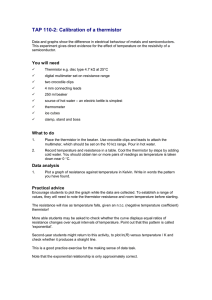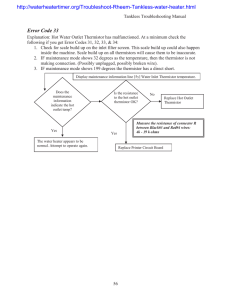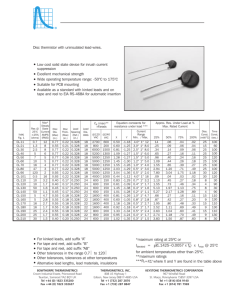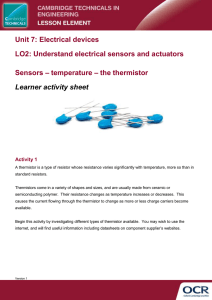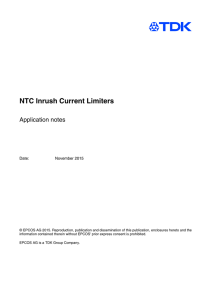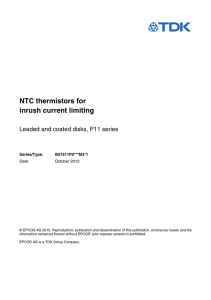NTC Inrush Current Limiter
advertisement
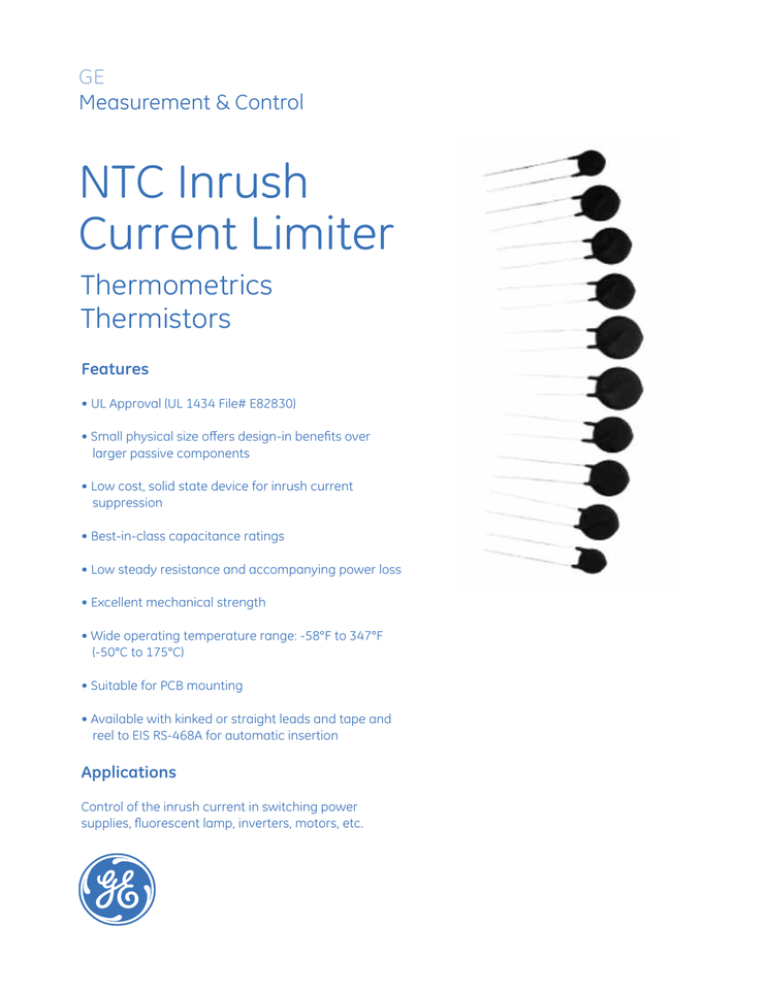
GE Measurement & Control NTC Inrush Current Limiter Thermometrics Thermistors Features • UL Approval (UL 1434 File# E82830) • Small physical size offers design-in benefits over larger passive components • Low cost, solid state device for inrush current suppression • Best-in-class capacitance ratings • Low steady resistance and accompanying power loss • Excellent mechanical strength • Wide operating temperature range: -58°F to 347°F (-50°C to 175°C) • Suitable for PCB mounting • Available with kinked or straight leads and tape and reel to EIS RS-468A for automatic insertion Applications Control of the inrush current in switching power supplies, fluorescent lamp, inverters, motors, etc. Inrush Current Limiters In Switching Power Supplies In the circuit above the maximum current at turn-on is the peak line voltage divided by the value of R; for 120 V, it is approximately 120 x √2/RI. Ideally, during turn-on RI should be very large, and after the supply is operating, should be reduced to zero. The NTC thermistor is ideally suited for this application. It limits surge current by functioning as a power resistor which drops from a high cold resistance to a low hot resistance when heated by the current flowing through it. Some of the factors to consider when designing NTC thermistor as an inrush current limiter are: • Maximum permissible surge current at turn-on • Matching the thermistor to the size of the filter capacitors • Maximum value of steady state current • Maximum ambient temperature • Expected life of the power supply Maximum Surge Current The main purpose of limiting inrush current is to prevent components in series with the input to the DC/ DC convertor from being damaged. Typically, inrush protection prevents nuisance blowing of fuses or breakers as well as welding of switch contacts. Since most thermistor materials are very nearly ohmic at any given temperature, the minimum no-load resistance of the thermistor is calculated by dividing the peak input voltage by the maximum permissible surge current in the power supply (Vpeak/Imax surge). Energy Surge at Turn-On At the moment the circuit is energized, the filter caps in a switcher appear like a short circuit which, in a relatively short period of time, will store an amount of energy equal to 1/2CV2. All of the charge that the filter capacitors store must flow through the thermistor. The net effect of this large current surge is to increase the temperature of the thermistor very rapidly during the period the capacitors are charging. The amount of energy generated in the thermistor during this capacitor-charging period is dependent on the voltage waveform of the source charging the capacitors. However, a good approximation for the energy generated by the thermistor during this period is 1/2CV2 (energy stored in the filter capacitor). The ability of the NTC thermistor to handle this energy surge is largely a function of the mass of the device. This logic can be seen in the energy balance equation for a thermistor being self-heated: ~ DC/DC Converter The problem of current surges in switch-mode power supplies is caused by the large filter capacitors used to smooth the ripple in the rectified 60 Hz current prior to being chopped at a high frequency. The diagram above illustrates a circuit commonly used in switching power supplies. Typical Power Supply Circuit Input Energy = Energy Stored + Energy Dissipated or in differential form: Pdt = HdT + δ(T – TA)dt where: P = Power generated in the NTC t = Time H = Heat capacity of the thermistor T = Temperature of the thermistor body δ = Dissipation constant TA = Ambient temperature During the short time that the capacitors are charging (usually less than 0.1 second), very little energy is dissipated. Most of the input energy is stored as heat in the thermistor body. In the table of standard inrush limiters there is listed a recommended value of maximum capacitance at 120 V and 240 V. This rating is not intended to define the absolute capabilities of the thermistors; instead, it is an experimentally determined value beyond which there may be some reduction in the life of the inrush current limiter. Maximum Steady-State Current The maximum steady-state current rating of a thermistor is mainly determined by the acceptable life of the final products for which the thermistor becomes a component. In the steady-state condition, the energy balance in the differential equation already given reduces to the following heat balance formula: Power = I2R = δ(T – TA) As more current flows through the device, its steady-state operating temperature will increase and its resistance will decrease. The maximum current rating correlates to a maximum allowable temperature. In the table of standard inrush current limiters is a list of values for resistance under load for each unit, as well as a recommended maximum steady-state current. These ratings are based upon standard PC board heat sinking, with no air flow, at an ambient temperature of 77° (25°C). However, most power supplies have some air flow, which further enhances the safety margin that is already built into the maximum current rating. To derate the maximum steady state current for operation at elevated ambient temperatures, use the following equation: Iderated = √(1.1425–0.0057 x TA) x Imax @ 77°F (25°C) Type CL Specifications • For tape and reel, add suffix “B” • Other tolerances in the range 0.7 Ω to 120 Ω • Other tolerances, tolerances at other temperatures • Alternative lead lengths, lead materials, insulations NTC discs for inrush current limiting Data *maximum rating at 77°F (25ºC) or Iderated = √(1.1425–0.0057 x TA) x Imax @ 77°F (25°C) for ambient temperatures other than 77°F (25ºC). **maximum ratings ***R0=X1Y where X and Y are found in the table below Description Disc thermistor with uninsulated lead-wires. Options • For kinked leads, add suffix “A” CxMax ** (μ Farads) Max. Disc Dia. in (mm) Max. Disc Thick. in (mm) Equation Constants for resistance under load *** Approximate Resistance Load at % Maximum Rated Max . Current Flow @ 25°C and 240 V Rms (Amps) Current Range Min I Max I 25% 50% 75% 100% Dissip. Time Constant (sec.) -1.18 4<1<12 0.14 0.06 0.04 0.03 25 100 457 0.6 -1.25 3<1<8 0.25 0.11 0.06 0.04 15 60 246 43.20 0.81 -1.25 2.5<1<8 0.34 0.14 0.09 0.06 25 100 128 1300 37.44 1.09 -1.27 1.5<1<6 0.65 0.27 0.16 0.11 25 100 64 5000 1250 36.00 1.28 -1.27 1.5<1<5 0.96 0.40 0.24 0.17 25 120 46 0.22 (5.59) 5000 1250 36.00 1.45 -1.3 1.2<1<5 1.08 0.44 0.26 0.18 25 100 32 0.77 (19.56) 0.22 (5.59) 5000 1250 36.00 1.55 -1.26 1<1<4 1.55 0.65 0.39 0.27 25 100 20 3 0.77 (19.56) 0.22 (5.59) 5000 1250 36.00 2.03 -1.29 0.5<1<3 2.94 1.20 0.71 0.49 25 100 7 120 2 0.93 (23.62) 0.22 (5.59) 5000 1250 36.00 3.04 -1.36 0.5<1<2 7.80 3.04 1.75 1.18 30 120 3 CL-101 0.5 16 0.93 (23.62) 0.22 (5.59) 4000 1000 28.80 0.44 -1.12 4<1<16 0.09 0.04 0.03 0.02 30 120 640 CL-110 10 3.2 0.40 (10.16) 0.17 (4.32) 600 150 4.32 0.83 -1.29 0.7<1<3.2 1.11 0.45 0.27 0.19 8 30 32 CL-120 10 1.7 0.40 (10.16) 0.17 (4.32) 600 150 4.32 0.61 -1.09 0.4<1<1.7 1.55 0.73 0.47 0.34 4 90 32 CL-130 50 1.6 0.45 (11.43) 0.17 (4.32) 600 150 4.32 1.45 -1.38 0.4<1<1.6 5.13 1.97 1.13 0.76 8 30 6 CL-140 50 1.1 0.45 (11.43) 0.17 (4.32) 600 150 4.32 1.01 -1.28 0.2<1<1.1 5.27 2.17 1.29 0.89 4 90 6 CL-150 5 4.7 0.55 (13.97) 0.18 (4.57) 1600 400 11.52 0.81 -1.26 1<1<4.7 0.66 0.28 0.17 0.12 15 110 64 CL-160 5 2.8 0.55 (13.97) 0.18 (4.57) 1600 400 11.52 0.6 -1.05 0.8<1<2.8 0.87 0.42 0.28 0.20 9 130 64 CL-170 16 2.7 0.55 (13.97) 0.18 (4.57) 1600 400 11.52 1.18 -1.28 0.5<1<2.7 1.95 0.80 0.48 0.33 15 110 20 CL-180 16 1.7 0.55 (13.97) 0.18 (4.57) 1600 400 11.52 0.92 -1.18 0.4<1<1.7 2.53 1.11 0.69 0.49 9 130 20 CL-190 25 2.4 0.55 (13.97) 0.18 (4.57) 800 200 5.76 1.33 -1.34 0.5<1<2.4 2.64 1.04 0.61 0.41 15 110 13 CL-200 25 1.7 0.55 (13.97) 0.18 (4.57) 800 200 5.76 0.95 -1.24 0.4<1<1.7 2.74 1.16 0.70 0.49 9 130 13 CL-210 30 1.5 0.40 (10.16) 0.2 (5.08) 600 150 4.32 1.02 -1.35 0.3<1<1.5 3.83 1.50 0.87 0.59 8 30 11 Resistance @ 25°C (Ω) ±25% *Max. Steady State CL-11 0.7 12 0.77 (19.56) 0.22 (5.59) 2700 675 19.44 0.5 CL-21 1.3 8 0.55 (13.97 0.21 (5.33) 800 200 5.76 CL-30 2.5 8 0.77 (19.56) 0.22 (5.59) 6000 1500 CL-40 5 6 0.77 (19.56) 0.22 (5.59) 5200 CL-50 7 5 0.77 (19.56) 0.26 (6.60) CL-60 10 5 0.77 (19.56) CL-70 16 4 CL-80 47 CL-90 Type @120 (VAC Rms) @240 (VAC Rms) Max. Energy (Joules) X Y Selection Criteria for GE CL-Products 1. I max - GE’s CLs are rated for maximum steady state current. The maximum steady current is mainly determined by the acceptable life of the final products for which the thermistor becomes a component. The differential equation Pdt = HdT + δ(T – TA)dt reduces to Power = I2R = δ(T – TA). An example in the case of a 100 watt power supply with an efficiency rating of 80%, 100% load is calculated to be 125 watts. The maximum input current is calculated from the minimum supply voltage. For a standard 120V supply, this could be rated as low at 110V. Therefore, input current would be calculated by 125 watts/110 V = 1.14 Amps. Selection of the CL should have an I max rating of at least 1.14 Amps. 2. The second step of selection of the CL is to understand the desired maximum inrush current allowable. This is generally specificed by the components in line of the CL, such as the diode bridge. In the case of the diode bridge rated at 200 Amps, one would should select a CL that would limit max surge current to 50% of the rating, therefore limit surge to a maximum of 100 Amps. The listed maximum current flow is rated at 25°C, so derating is required if the ambient temperture is greater than 25°C. 3. The next selection of criteria for the CL is to understand the bulk Capacitance of the device to be protected. On power, the bulk capacitance of the device appears as a short to the system. The designer needs to understand the bulk capacitance at the RMS voltage rating of the system. Assuming the input capacitance is approximately 500 μFds, the selection of the CL needs to be able to absorb input energy. Using the above criteria, the selection of the CL provides multiple solutions. One would opt for the smallest size CL to achieve the required protection. The selection criteria is as follows: 1. I max >1.14 Amps 2. Max allowable Inrush current 100 Amps 3. Bulk Capacitance listed as 500 μfd 4. Choose smallest physical size that will allow protection for the device. Criteria indicates that either the CL-150 or CL-160 would be suitable for the application. In the case of the CL-150 less heat is dissipated allowing the operating resistance to drop but at a higher temperature. This increases efficiency of the system but may lead to shorter component life. www.ge-mcs.com 920-325D © 2013 General Electric Company. All Rights Reserved. Specifications are subject to change without notice. GE is a registered trademark of General Electric Company. Other company or product names mentioned in this document may be trademarks or registered trademarks of their respective companies, which are not affiliated with GE. Mouser Electronics Authorized Distributor Click to View Pricing, Inventory, Delivery & Lifecycle Information: GE Measurement & Control: CL-140 CL-180 CL-101 CL-160 CL-120 CL-190 CL-110 CL-150 CL-130 CL-170 CL-210 CL-200 CL-80A CL40 CL-80 CL-60 CL-21 CL-30 CL-70 CL-50 CL-11 CL-90 CL-40A CL-50A CL-60A CL-70A CL-90A CL-110A CL-120A CL-130A CL-140A CL-150A CL-160A CL-170A CL-180A CL-190A CL-200A CL-210A CL-11A CL-21A CL-101A CL-30B CL-30A

